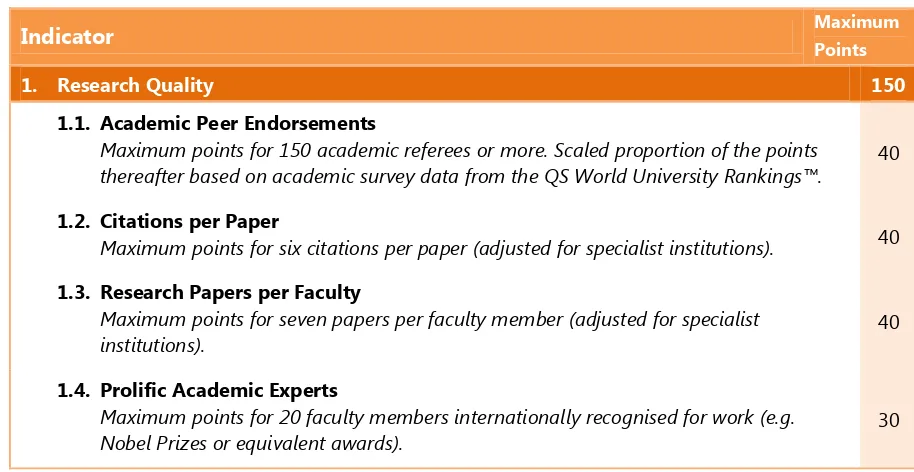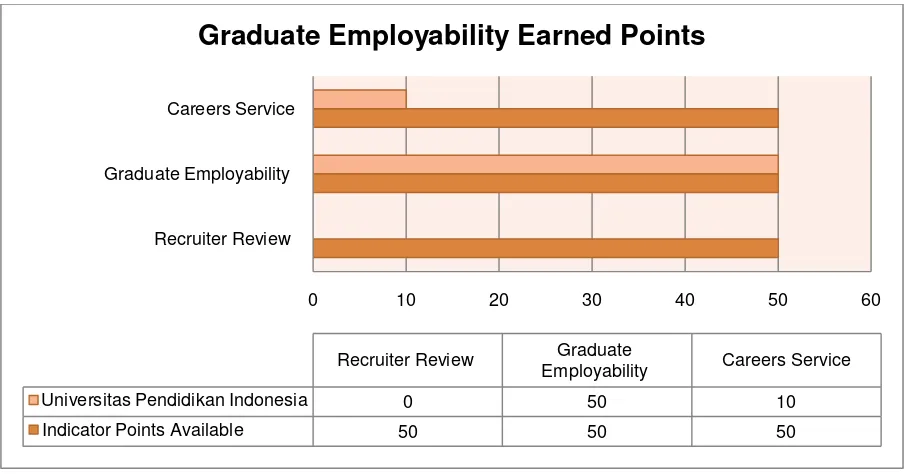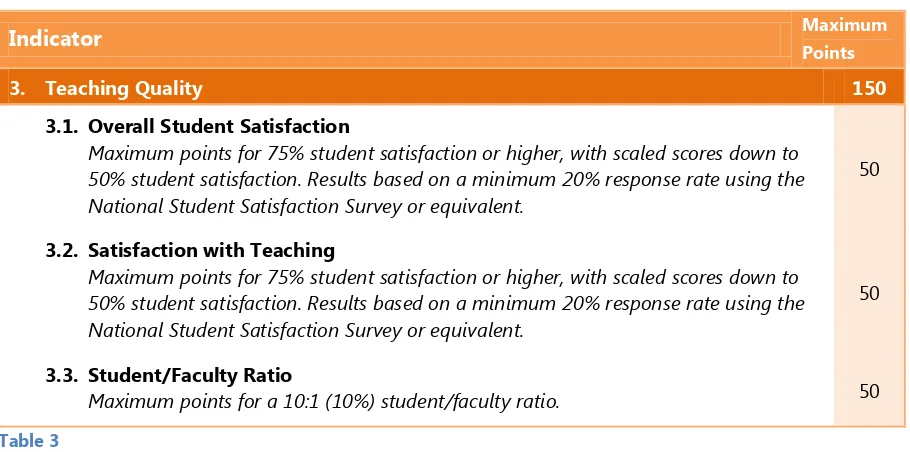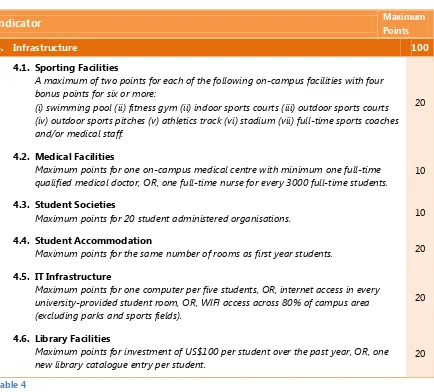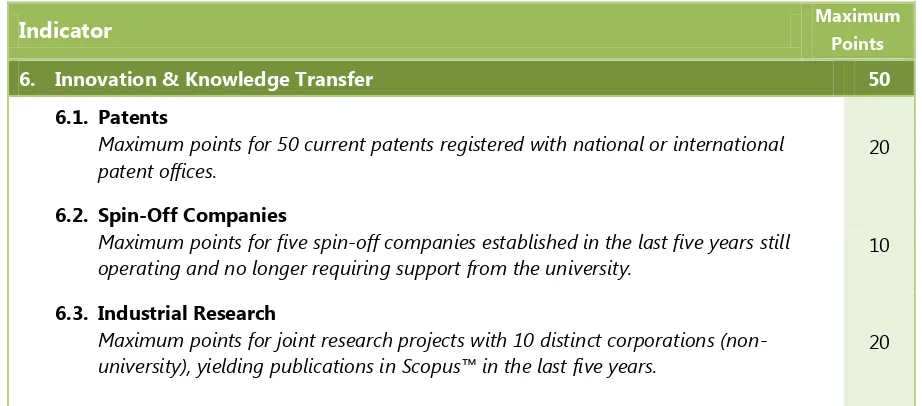QS Stars–© 2010 QS Intelligence Unit (a division of QS Quacquarelli Symonds Ltd)
QS Stars Development Road Map
QS Stars– © 2010 QS Intelligence Unit (a division of QS Quacquarelli Symonds Ltd) Page | 1
Contents
Introduction... 2
Core Criteria ... 3
Research Quality ... 3
Graduate Employability ... 5
Teaching Quality ... 6
Infrastructure ... 8
Advanced Criteria ... 11
Internationalization ... 11
Innovation and Knowledge Transfer ... 12
Third Mission ... 13
Specialist Criteria ... 16
QS Stars– © 2010 QS Intelligence Unit (a division of QS Quacquarelli Symonds Ltd) Page | 2
Introduction
The QS Stars Development Road Map builds upon many years of experience collecting institutional data and compiling the QS World University Rankings™. The objective is to provide institutions with a broader range of criteria that allow them to stand out in their particular area(s) of excellence. The QS Stars system evaluates universities against a range of important performance indicators based on a rating method. It awards Stars to an institution according to a range of criteria and can include universities not traditionally well-placed in rankings.
A Star rating can visually signal additional complexity beneath ranking results. It can encourage users and readers to accept that ranking results ought to be understood rather than simply accepted. It can also provide additional important information that is involved in the early stage of the university application decision-making process.
Ratings are not dependent on the performance of other institutions, but relate to an
individual institution‟s performance, which is measured against pre-set thresholds.
Further Assistance
If you need any further help interpreting the content of this report, have any questions or have discovered any anomalies, please contact QS. Detailed feedback and ideas for improvements are also very welcome: if there is any data of interest that could be collected in the future, it can be considered and potentially added to the project.
Deena Al-Hilli
Project Manager QS Stars deena@qs.com
+44 (0)20 7428 2793
Stephanie Braudeau
Junior Analyst
stephanie.braudeau@qs.com
QS Stars– © 2010 QS Intelligence Unit (a division of QS Quacquarelli Symonds Ltd) Page | 3
Core Criteria
The following section of the report contains the results obtained by Universitas Pendidikan Indonesia in each category of the Core Criteria. These criteria feature the key building blocks of a university whether focused globally, domestically or locally.
Research Quality
Indicators considered here include domestic assessments of research quality, productivity (i.e. number of papers published), citations (i.e. how recognised and referred to those papers are by other academics) and awards (e.g. Nobel Prizes or Fields Medals).
Indicator Maximum
Points
1. Research Quality 150
1.1. Academic Peer Endorsements
Maximum points for 150 academic referees or more. Scaled proportion of the points thereafter based on academic survey data from the QS World University Rankings™.
40
1.2. Citations per Paper
Maximum points for six citations per paper (adjusted for specialist institutions). 40
1.3. Research Papers per Faculty
Maximum points for seven papers per faculty member (adjusted for specialist institutions).
40
1.4. Prolific Academic Experts
Maximum points for 20 faculty members internationally recognised for work (e.g. Nobel Prizes or equivalent awards).
30
Table 1
QS Stars– © 2010 QS Intelligence Unit (a division of QS Quacquarelli Symonds Ltd) Page | 4 Figure 1
Figure 1 displays the performance of Universitas Pendidikan Indonesia against the maximum number of points available in each Research Quality indicator. Universitas Pendidikan Indonesia has not met the requirements within this criterion, increasing the number of research papers per faculty will help achieve a higher score in this category.
0 5 10 15 20 25 30 35 40 45
Peer review data Citations per paper Research papers per faculty Prolific academic experts
Peer review data Citations per
paper
Research papers per
faculty
Prolific academic
experts
Universitas Pendidikan Indonesia 0 0 0 0
Maximum Number of Points
available 40 40 40 30
QS Stars– © 2010 QS Intelligence Unit (a division of QS Quacquarelli Symonds Ltd) Page | 5
Graduate Employability
Graduate employability encompasses more than academic strength, focusing on „work
-readiness‟ - the ability to work effectively in a multi-cultural team, to deliver presentations, to manage people and projects. Common indicators in this area are surveys of employers, graduate employment rates and level of career service support.
Indicator Maximum
Points
2. Graduate Employability 150
2.1. Recruiter Review
Maximum points for 40 employer referees or more. Scaled proportion of the points thereafter based on employer survey data from the QS World University Rankings™.
50
2.2. Graduate Employability
Maximum points for 80% of graduated students employed within 12 months of graduation or accepted for further studies.
50
2.3. Careers Service Support
Maximum points for 10 full-time careers advisers, OR, one full-time career adviser per 1000 students.
50
Table 2
Table 2 displays the maximum allocated points within the Graduate Employability Criteria. The points are evenly distributed between these criteria.
Figure 2
Figure 2 shows the maximum number of points available within Graduate Employability against the number of points achieved by Universitas Pendidikan Indonesia. Universitas
0 10 20 30 40 50 60
Recruiter Review Graduate Employability Careers Service
Recruiter Review Graduate
Employability Careers Service
Universitas Pendidikan Indonesia 0 50 10
Indicator Points Available 50 50 50
QS Stars– © 2010 QS Intelligence Unit (a division of QS Quacquarelli Symonds Ltd) Page | 6
Pendidikan Indonesia has met the indicator requirements for Graduate Employability; improving relations with Employers may help its results in the recruiter review indicator. This area represents a key strength that Universitas Pendidikan Indonesia should maintain.
Teaching Quality
A key role of a university is the nurture of tomorrow's finest minds, inspiring the next generation of potential research academics. Typical indicators here are domestic teaching quality assessments, collation of student feedback, national student surveys and student faculty ratios.
Indicator Maximum
Points
3. Teaching Quality 150
3.1. Overall Student Satisfaction
Maximum points for 75% student satisfaction or higher, with scaled scores down to 50% student satisfaction. Results based on a minimum 20% response rate using the National Student Satisfaction Survey or equivalent.
50
3.2. Satisfaction with Teaching
Maximum points for 75% student satisfaction or higher, with scaled scores down to 50% student satisfaction. Results based on a minimum 20% response rate using the National Student Satisfaction Survey or equivalent.
50
3.3. Student/Faculty Ratio
Maximum points for a 10:1 (10%) student/faculty ratio. 50
Table 3
QS Stars– © 2010 QS Intelligence Unit (a division of QS Quacquarelli Symonds Ltd) Page | 7 Figure 3
Figure 3 shows the maximum number of points available for Teaching Quality against the number of points achieved by Universitas Pendidikan Indonesia. The chart displays that the student faculty ratio indicator has been met, however improvement in teaching is needed in order to increase student satisfaction, Universitas Pendidikan Indonesia should focus particularly on teaching.
0 10 20 30 40 50 60
Overall Student Satisfaction (National Student Survey or
equivalent) Satisfaction with Teaching
Student/faculty ratio
Overall Student Satisfaction (National
Student Survey or equivalent)
Satisfaction with
Teaching Student/faculty ratio
Universitas Pendidikan Indonesia 22 14 50
Indicator Points Available 50 50 50
QS Stars– © 2010 QS Intelligence Unit (a division of QS Quacquarelli Symonds Ltd) Page | 8
Infrastructure
University infrastructure is an indicator which enables students to know what to expect from their university experience.
Indicator Maximum
Points
4. Infrastructure 100
4.1. Sporting Facilities
A maximum of two points for each of the following on-campus facilities with four bonus points for six or more:
(i) swimming pool (ii) fitness gym (ii) indoor sports courts (iii) outdoor sports courts (iv) outdoor sports pitches (v) athletics track (vi) stadium (vii) full-time sports coaches and/or medical staff.
20
4.2. Medical Facilities
Maximum points for one on-campus medical centre with minimum one full-time qualified medical doctor, OR, one full-time nurse for every 3000 full-time students.
10
4.3. Student Societies
Maximum points for 20 student administered organisations. 10
4.4. Student Accommodation
Maximum points for the same number of rooms as first year students. 20
4.5. IT Infrastructure
Maximum points for one computer per five students, OR, internet access in every university-provided student room, OR, WIFI access across 80% of campus area (excluding parks and sports fields).
20
4.6. Library Facilities
Maximum points for investment of US$100 per student over the past year, OR, one new library catalogue entry per student.
20
Table 4
QS Stars– © 2010 QS Intelligence Unit (a division of QS Quacquarelli Symonds Ltd) Page | 9 Figure 4
Figure 4 displays the number of earned points against the maximum number of points available. Universitas Pendidikan Indonesia met the requirements of three of the Infrastructure indicators; however a slight improvement in IT Infrastructure is required. This could be achieved by increasing the number of computers on campus/in student rooms or widening the range of WIFI access across campus. An improvement in student accommodation will also help improve Universitas Pendidikan Indonesia‟s overall score.
0 5 10 15 20 25
Sport facilities - On-campus or access to:
Universitas Pendidikan Indonesia 20 10 10 0 8 2
Indicator Points Available 20 10 10 20 20 20
QS Stars– © 2010 QS Intelligence Unit (a division of QS Quacquarelli Symonds Ltd) Page | 10 Figure 5
Figure 5 displays Universitas Pendidikan Indonesia„s results in each category of the Core Criteria. The total number of points that can be achieved within each category is displayed against the number of points achieved by the university. The Lower Bar displays Universitas Pendidikan Indonesia‟s individual points: an overall 196 were achieved from the 550 points available.
It is clear from the chart that Universitas Pendidikan Indonesia is achieving excellent results with its graduates: the majority of graduated students are either pursuing further education or have been employed. Teaching Quality is of good standard. However, the chart indicates that improvements in Infrastructure and Research will improve the overall score.
Research Quality Graduate
Employability Teaching Quality Infrastructure
0 100 200 300 400 500
Universitas Pendidikan Indonesia Earned Points
Indicator Points Available
Universitas Pendidikan Indonesia Earned
Points Indicator Points Available
Research Quality 0 150
Graduate Employability 60 150
Teaching Quality 86 150
Infrastructure 50 100
QS Stars– © 2010 QS Intelligence Unit (a division of QS Quacquarelli Symonds Ltd) Page | 11
Advanced Criteria
For a university to aspire to being truly world-class, its mission and its impact must extend further than the basics. This selection of criteria looks at important factors that a university with a solid foundation in the core criteria might target to advance to a higher level of performance and recognition.
Internationalization
Here, effective indicators could be the proportion of international students and staff, the numbers of exchange students arriving and departing, the number and strength of international partnerships with other universities or the number of graduates pursuing further study at overseas universities.
Indicator Maximum
Points
5. Internationalization 150
5.1. International Faculty
Maximum points for 25% international faculty. 20
5.2. Institution Research Collaborations
Maximum points for 25 university research collaborations with QS top 500 universities
in the previous three years’ published Rankings. 50
5.3. International Students
Maximum points for 20% international students. 20
5.4. International Student Support - Religious Facilities
Maximum points for at least one place of worship for a minimum of three major religious groups (e.g. Christianity, Islam, Sikhism/Hinduism, Buddhism, Taoism, Judaism), OR, a multi-denominational religious facility.
10
5.5. Inbound/Outbound Exchange Students
Maximum points for 25 inbound and outbound student exchange agreements. 50
Table 5
QS Stars– © 2010 QS Intelligence Unit (a division of QS Quacquarelli Symonds Ltd) Page | 12 Figure 6
Figure 6 shows the maximum number of points available within Internationalisation against the number of points achieved by Universitas Pendidikan Indonesia. Most of the indicator requirements have been met by Universitas Pendidikan Indonesia; a key area to focus on is the number of international students enrolled at the university.
Innovation and Knowledge Transfer
Indicator Maximum
Points
6. Innovation & Knowledge Transfer 50
6.1. Patents
Maximum points for 50 current patents registered with national or international patent offices.
20
6.2. Spin-Off Companies
Maximum points for five spin-off companies established in the last five years still operating and no longer requiring support from the university.
10
6.3. Industrial Research
Maximum points for joint research projects with 10 distinct corporations (non-university), yielding publications in Scopus™ in the last five years.
20
Universitas Pendidikan Indonesia 5 26 0 10 30
Indicator Points Available 20 50 20 10 50
QS Stars– © 2010 QS Intelligence Unit (a division of QS Quacquarelli Symonds Ltd) Page | 13
Table 6 displays the distribution of maximum allocated points within the Innovation & Knowledge Transfer Criteria.
Figure 7
Figure 7 shows the maximum number of points available within the Innovation & Knowledge Transfer criteria against the number of points achieved by Universitas Pendidikan Indonesia. The chart clearly displays that most of the indicator requirements have not been met; this is an area d that Universitas Pendidikan Indonesia should focus on. Increasing the number of patents registered, creating spin off companies and increasing the number of industrial research projects published in Scopus can help improve this area.
Third Mission
Indicator Maximum
Points
7. Third Mission 50
7.1. Community Investment & Development
Maximum points for 1% of turnover or US$2 million (whichever is smaller) contribution to community projects within 200km of any campus or affiliated facility.
25
7.2. Needs-based Scholarships and Bursaries
Maximum points for attendance made possible for 100 students on full scholarships on a needs basis.
Patents Spin-off companies Industrial research
Universitas Pendidikan
Indonesia 1 2 0
Indicator Points Available 20 10 20
QS Stars– © 2010 QS Intelligence Unit (a division of QS Quacquarelli Symonds Ltd) Page | 14
Table 7 displays the distribution of maximum allocated points within the Third Mission Indicator. The points are evenly distributed in these criteria.
Figure 8
Figure 8 shows the maximum number of points available within the Third Mission indicator against the number of points achieved by Universitas Pendidikan Indonesia. This area is a strength that Universitas Pendidikan Indonesia should maintain, increasing the number of
scholarships offered to students will improve the university‟s score and meet the indicator
requirement.
0 5 10 15 20 25 30
Community Investment & Development Needs based scholarships and
Bursaries
Community Investment & Development
Needs based scholarships and Bursaries
Universitas Pendidikan Indonesia 25 9
Indicator Points Available 25 25
QS Stars– © 2010 QS Intelligence Unit (a division of QS Quacquarelli Symonds Ltd) Page | 15 Figure 9
Figure 9 displays Universitas Pendidikan Indonesia‟s results for each the Additional Criteria section. The total numbers of points that can be achieved are displayed in the chart against the number of points achieved by the university. Universitas Pendidikan Indonesia achieved 108 points from the 250 available.
Most of the points available in this section are drawn from the internationalization criteria. Table 5 illustrates the distribution of the points, principally focusing on internationalization. It reveals that Universitas Pendidikan Indonesia focuses on internationalization, however
further focus could help improve the university‟s score.
Internationalisation Innovation &
Knowledge Transfer
Third Mission
0 50 100 150 200 250
Universitas Pendidikan Indonesia Earned Points
Indicator Points Available
Universitas Pendidikan Indonesia
Earned Points Indicator Points Available
Internationalisation 71 150
Innovation & Knowledge Transfer 3 50
Third Mission 34 50
QS Stars– © 2010 QS Intelligence Unit (a division of QS Quacquarelli Symonds Ltd) Page | 16
Specialist Criteria
Indicator Maximum
Points
8. Rank in Specialist Subject 200
Broad Faculty Area Ranking
Highly ranked in any one of five broad specialist areas based on QS ranking systems in (i) IT & Engineering (ii) Natural Sciences (iii). Life Sciences (iv) Arts & Humanities (v) Social Sciences. Maximum points for ranked positions 1-20; scaled scores down to position 300.
OR
Narrow Subject Area Rankings
Two highest scoring disciplines based on one of the subject area rankings in the QS ranking systems or on reliable third party evaluations Maximum points for ranked positions 1-20; scaled scores down to a minimum of 25 points at position 100.
OR
Internationally Recognised Accreditations
25 points per accreditation up to a maximum of 50.
Table 8
Table 8 displays the distribution of maximum allocated points between two different categories within the specialist criteria section.
Figure 10
Figure 10 displays the results for Universitas Pendidikan Indonesia in the Specialist Criteria. The total number of points that can be achieved is displayed in the chart against the
Earned Points Indicator Points Available
Broad faculty area rankings 0 200
QS Stars– © 2010 QS Intelligence Unit (a division of QS Quacquarelli Symonds Ltd) Page | 17
number of points achieved by the university. Universitas Pendidikan Indonesia achieved 0 points from the 200 available.
Figure 11
Figure 11 displays the overall results for Universitas Pendidikan Indonesia. 304 points were earned from the 1000 points available. As a result, Universitas Pendidikan Indonesia is awarded Two Stars.
Core Criteria
Additonal Criteria
Specialist Criteria
0 100 200 300 400 500 600 700 800 900 1000
Universitas Pendidikan Indonesia Earned Points
Criteria Points Available
Universitas Pendidikan Indonesia Earned
Points Criteria Points Available
Core Criteria 196 550
Additonal Criteria 108 250
Specialist Criteria 0 250
QS Stars– © 2010 QS Intelligence Unit (a division of QS Quacquarelli Symonds Ltd) Page | 18 Figure 12
Figure 12 displays the different level of Stars available. Each red bar indicates the minimum number of points required for each Star level. Universitas Pendidikan Indonesia earned 304 points, therefore it is awarded Two Stars, (the minimum number of points required to achieve Two Stars is 250 points.)
100
250
400
550
700
0 100 200 300 400 500 600 700 800 900 1000
1 star 2 stars 3 stars 4 stars 5 stars
Number of Points
Num
be
r
of
Sta
rs
Star Allocation Chart
QS Stars– © 2010 QS Intelligence Unit (a division of QS Quacquarelli Symonds Ltd) Page | 19
Conclusion
Universitas Pendidikan Indonesia‟s key strength is its internationalization status, which has
helped them achieve their “Two Star” status. Improvement in several areas is needed for the university to be awarded a higher star status, these include:
1. Research quality:
a. Universitas Pendidikan Indonesia currently has a very low number of citations and publications, an improvement on this number can help improve their research faculty.
2. Infrastructure:
a. Overall improvement of the university‟s infrastructure can help improve the
university‟s overall star status. This can be an increase in student
accommodation and library catalogues. 3. Innovation & Knowledge Transfer
a. As mentioned in the report, focus on Innovation & Knowledge Transfer could
improve the university‟s score. This could be an increase of registered patents
or increasing the number of joint research projects. 4. Broad and Narrow Area Faculty Rankings
a. The university did not achieve any points in this criteria, this indicates that Universitas Pendidikan Indonesia does not specialize in any particular subject area.
